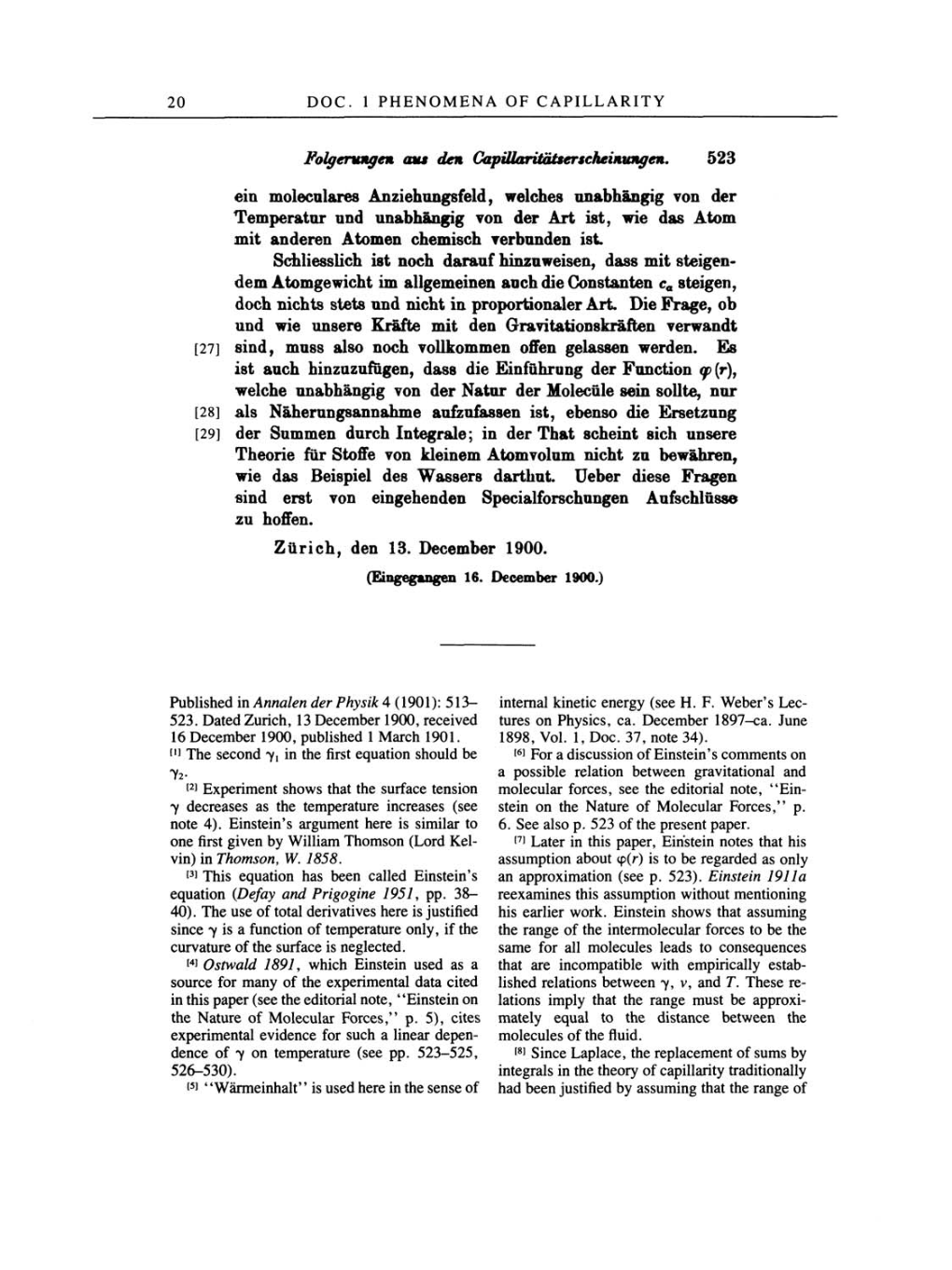20 DOC.
1
PHENOMENA OF CAPILLARITY
Folgerungen aus
den
Capillaritätserscheinungen.
523
ein moleculares
Anziehungsfeld,
welches
unabhängig
von
der
Temperatur
und
unabhängig von
der Art
ist, wie
das Atom
mit
anderen Atomen
chemisch
verbunden ist.
Schliesslich
ist
noch
darauf
hinzuweisen,
dass
mit
steigen-
dem
Atomgewicht
im
allgemeinen
auch die Constanten
ca
steigen,
doch
nichts
stets und
nicht in
proportionaler
Art. Die
Frage,
ob
und
wie
unsere
Kräfte mit den
Gravitationskräften verwandt
[27]
sind,
muss
also noch vollkommen
offen
gelassen
werden.
Es
ist
auch
hinzuzufügen,
dass die
Einführung
der Function
cp(r),
welche
unabhängig
von
der
Natur der
Molecule
sein
sollte,
nur
[28]
als
Näherungsannahme
aufzufassen
ist,
ebenso die
Ersetzung
[29]
der
Summen
durch
Integrale;
in der
That
scheint sich
unsere
Theorie fur
Stoffe
von
kleinem Atomvolum
nicht
zu
bewähren,
wie
das
Beispiel
des Wassers
darthut.
Ueber diese
Fragen
sind erst
von
eingehenden Specialforschungen
Aufschlüsse
zu
hoffen.
Zürich, den
13.
December 1900.
(Eingegangen
16.
December
1900.)
Published
in Annalen
der
Physik
4
(1901):
513-
523. Dated Zurich,
13
December
1900,
received
16
December
1900,
published
1
March 1901.
[1]
The second
Y1
in the first
equation
should be
Y2.
[2] Experiment
shows that the surface tension
Y
decreases
as
the
temperature
increases
(see
note
4).
Einstein's
argument
here is similar
to
one
first
given by
William
Thomson
(Lord
Kel-
vin)
in
Thomson, W.
1858.
[3]
This
equation
has been called
Einstein's
equation (Defay
and
Prigogine 1951,
pp.
38-
40).
The use
of
total derivatives here
is
justified
since
Y
is
a
function
of
temperature only,
if
the
curvature
of
the surface is
neglected.
[4]
Ostwald
1891,
which Einstein used
as a
source
for
many
of
the
experimental
data cited
in this
paper (see
the editorial
note,
"Einstein
on
the
Nature
of Molecular
Forces,"
p.
5),
cites
experimental
evidence for such
a
linear
depen-
dence
of
Y
on temperature
(see
pp.
523-525,
526-530).
[5]
"Wärmeinhalt"
is
used here in the
sense
of
internal kinetic
energy
(see
H. F.
Weber's
Lec-
tures
on
Physics,
ca.
December
1897-ca.
June
1898,
Vol.
1,
Doc.
37, note
34).
[6]
For
a
discussion
of Einstein's
comments
on
a possible
relation between
gravitational
and
molecular
forces,
see
the editorial note,
"Ein-
stein
on
the Nature
of
Molecular Forces,"
p.
6. See also
p.
523
of
the
present paper.
[7]
Later in this
paper,
Einstein
notes
that his
assumption
about
p(r)
is
to be
regarded
as only
an approximation (see p. 523).
Einstein
1911a
reexamines this
assumption
without
mentioning
his
earlier
work. Einstein shows
that
assuming
the
range
of the
intermolecular
forces
to
be
the
same
for
all molecules leads
to consequences
that
are
incompatible
with
empirically
estab-
lished
relations
between
Y, v,
and T. These
re-
lations
imply
that the
range
must
be
approxi-
mately
equal
to
the
distance
between
the
molecules
of
the fluid.
[8]
Since
Laplace,
the
replacement
of
sums by
integrals
in the
theory
of
capillarity traditionally
had been
justified by assuming
that the
range
of
